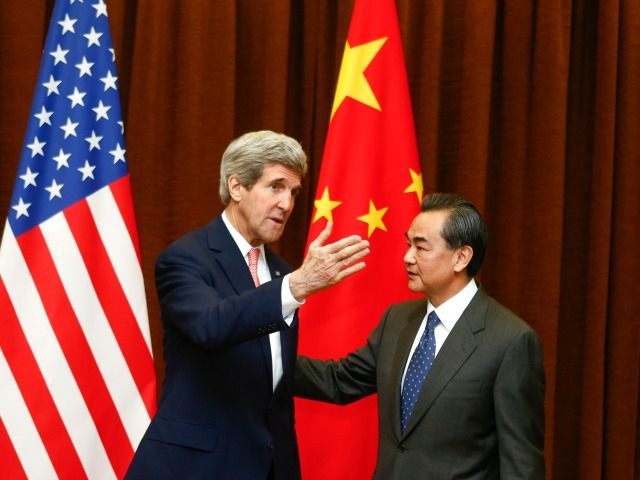Secretary of State John Kerry, visiting Mongolia on his way to China, warned Beijing Sunday that declaring an air defense zone over the South China Sea to be a “provocative and destabilizing act.”
The day before, Defense Secretary Ashton Carter had also cautioned China’s leaders against constructing a naval base and airfield on a South China Sea islet it seized from the Philippines in 2012. If China did so, Carter said, it would lead to “actions being taken” by the United States and other nations.
A Chinese admiral immediately responded by denouncing U.S. “provocations” in the South China Sea, saying that it does not fear “trouble” over its territorial claims.
Chinese Admiral Sun Jianguo, speaking at a security summit in Singapore on Sunday, declared: “The South China Sea issue has become overheated because of the provocations of certain countries for their own selfish interests.”
“We do not make trouble, but we have no fear of trouble,” he went on to say.
Of course, the “trouble” in the South China Sea is entirely of China’s making. It began in the late nineties, when China began to not only assert, but act upon its claim that the entire South China Sea, which stretches from Hainan Island hundreds of miles south to the equatorial waters off the coast of Borneo, was its own sovereign territory.
This is a breathtaking territorial claim — the Sea is roughly 1.4 million square miles, or half the size of the continental United States. If it is allowed to proceed, will constitute one of the largest land grabs in recent history.
China refers to the South China Sea as “blue earth,” saying that it has belonged to China “since ancient times.” Vietnam, Taiwan, Brunei, Malaysia, and the Philippines, among other claimants to the same waters, dispute this.
During the seven years of the Obama administration, Beijing has moved rapidly to create “facts on the ground” by building artificial islands on reefs and submerged rocks. To date, it has completed eight such “islands” (Gaven Reef, Hughes Reef, Subi Reef, Mischief Reef, Cuarteron Reef, Fiery Cross Reef, and Johnson Reef) and appears poised to begin a ninth on Scarborough Shoal, which it seized from the Philippines.
At the same time, it is militarizing the larger features by building harbors and runways. Jet fighters and surface-to-air missiles have now been deployed on Woody Island in the Paracels, a group of islets that are closer to China. Similar deployments will undoubtedly follow in the southernmost features as construction reaches completion.
American naval vessels and planes continue to transit the international waters and airspace of the South China Sea, although there have been close calls in the air and on the ground. In 2013, Chinese naval vessels forced a US Navy guided-missile cruiser, the USS Cowpens, to make an emergency course change to avoid a collision. This May, Chinese fighter jets nearly collided with a US Navy plane in mid-air, forcing it off course as well.
China cites continuing U.S. operations in the area as a pretext for its ongoing military build-up. The reality is that Beijing is systematically and methodically carrying out a strategic plan for the annexation of this vast area that was drawn up some years ago. If anything, China’s new communist dictator, Xi Jinping, has likely advanced the timetable.
As China’s military and economic clout has grown, Beijing would probably have grown bolder and brasher in any event. But Xi, who is also the Chairman of the Military Commission, is cut from the same cloth as the late Chairman Mao. Like Mao, Xi sometimes dresses up in a military uniform, something his bland bureaucratic predecessor would not have dreamed of doing. He seems intent upon making his mark — quickly — upon the world, and is not averse to using force to achieve it.
It has probably not escaped the Chinese leader how hesitant Obama has been to confront him over his blatant acts of aggression. While both the Secretary of State and the Secretary of Defense have spoken out against his moves in the South China Sea, the president himself has been silent. And in China, as in the courtroom, silence signifies assent.
Putin’s successful annexation of Crimea and control of parts of eastern Ukraine have probably also emboldened Xi, convincing him that the current American president was not likely to directly challenge his aggressive actions. If he needed more evidence of Obama’s fecklessness, he would only have to remind himself that when the current occupant of the White House did proclaim a “red line” in Syria, Dictator Bashar Assad crossed it with impunity.
Xi has seen how, with Obama slashing the Pentagon’s budget, the much-ballyhooed “pivot to Asia” has yet to materialize. Instead, the Obama years have seen the gradual dismantling of the greatest navy the world has ever seen. The U.S. Navy is the smallest it has been since 1917, and only about 100 warships are actually deployed.
Finally, China’s leader understands that, while he will continue to be in office for a decade or more, Obama’s term of office will expire in January 2017.
America will then have a new commander-in-chief. It may well be someone who has pledged to make American great again, and specifically to rebuild our army, navy, and air force.
Is it any wonder that Chairman Xi is on the move now, aggressively taking control of as much of the South China Sea as he can, before America has a new leader?
Steven W. Mosher is the President of the Population Research Institute and the author of Hegemon; China’s Plan to Dominate Asia and the World.

COMMENTS
Please let us know if you're having issues with commenting.